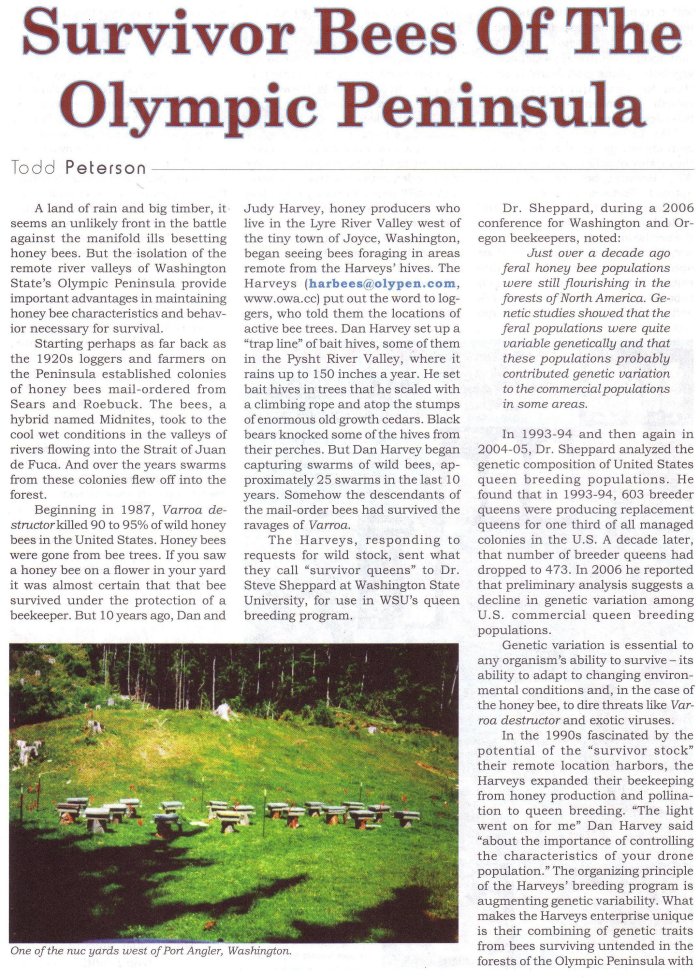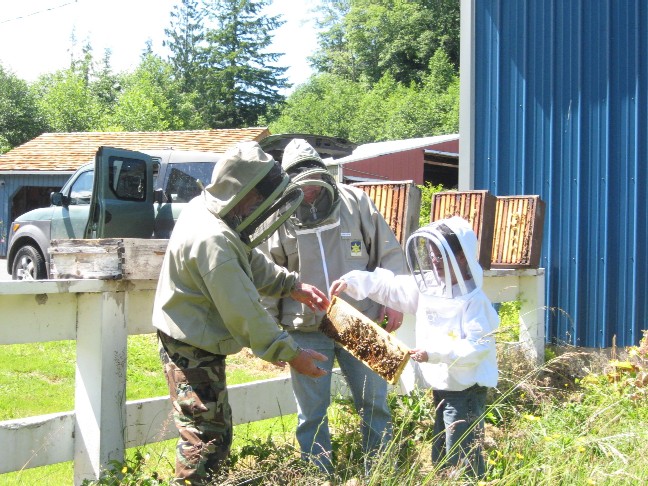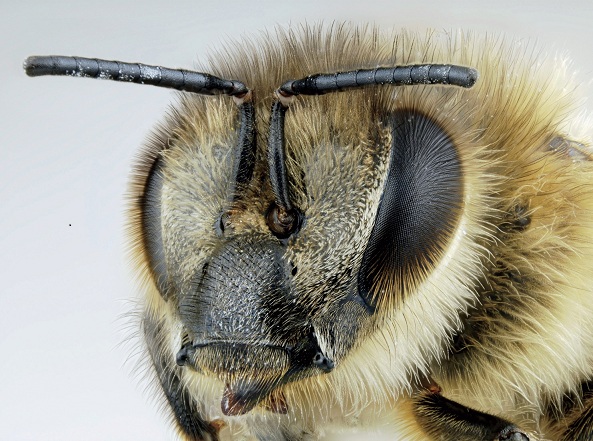NEXT UP, THE SURVIVORS
Part two of two parts. by M.E.A. McNeil
(Excerpted from American Bee Journal ~ April 2009 pp 355 – 356)
In 1997, Dan and Judy Harvey heard that most feral bees were wiped out by varroa
mites, and they went looking for survivors. Their Olympic Wilderness Apiary10 is located
in the temperate rain forest of the Northwestern Olympic Peninsula in WashingtonState.
They put out the word to loggers, and soon were collecting swarms. “We just assumed
they had some resistance,” he said. “We didn’t know what we were doing.” It was a steep
learning curve for them, finding out how to evaluate the bees and rear queens. They
came up with a combination of tests, which they still find effective: Erikson’s screen
wash test 11for mites, liquid nitrogen 12 for hygienic behavior and professional lab tests
for disease. They found a lot of variability and bred from the healthiest bees. In 2000
they began adding USDA genetics, first Russian and later VHS/SMR bees, as well as
semen for tracheal mite resistance from Baton Rouge. The initial aggressiveness of the
Russian stock was bred down. With no chemicals in the production colonies and an
overall IPM philosophy (antibiotic and organic mite control in mating nucs), handmade
chemical-free cappings wax foundation, and good grooming behavior in the bees
(evidenced by microscope observed bite marks on dead mites), Harvey said the program
worked out well. But in the spring of 2008, a freak weather pattern collided with the arrival
of the microsporidians Nosema ceranae, resulting in the loss of 90% of the carefully bred
colonies. Cold, wet weather persisted for a year, from one summer to the next, causing
pollen shortages and leaving nutritionally distressed bees going into winter and susceptible
to infection. Tests found very high levels of N.ceranae in his apiaries, but none in some feral
populations in the area. Harvey speculated that because microsporidians are common in
he naturally damp Northwest environment, the feral bees may defend themselves well from
them – after all, he observes, they deal with bears. J
He remarked that the fungus chalkbrood can be inhibited by probiotic yeasts and molds,
as well as by hygienic behavior. Down but not out, Harvey is breeding the nosema-free feral
bees with the survivors of the environmental pressures of last year. He thinks that the
advantages must go both ways; the genetics help the surrounding feral bees as well.
Working with bees in trees has led Harvey to conclude that standard hive systems hold
too much moisture. He leaves a 3/8” opening across the back and front of his hive tops.
Observing how high in the tree cavity the nest is naturally built, far from potentially
infectious hive debris, he is experimenting with an added empty 6 5/8sterilized box on the
bottom board. In the spirit of natural selection surfers, the Harvey’s have stayed afloat through
the latest crisis, “greatly encouraged to find ourselves once again in a unique situation.”
Footnotes
10 http://www.wildernessbees.com
11 Erickson, Eric, American Bee Journal,
August 2000
12 http://www.beeculture.com/storycms/
index.cfm?cat=Story&recordID=290
(Excerpted from American Bee Journal ~ April 2009 pp 355 – 356)



 Three generations of beekeepers
Three generations of beekeepers The last time we checked with Seattle mayor-turned-beekeeper Wes Uhlman, his two hives on Queen Anne Hill were doing fine. It was three years ago, and all across farm country a mysterious syndrome called colony collapse disorder was making bees abandon their doomed hives, threatening an agricultural catastrophe. But CCD hadn’t slammed Uhlman or his fellow local backyard beekeepers as severely as others. That made him suspect that Big Ag pesticides—not a big factor on Queen Anne—were the cause.
The last time we checked with Seattle mayor-turned-beekeeper Wes Uhlman, his two hives on Queen Anne Hill were doing fine. It was three years ago, and all across farm country a mysterious syndrome called colony collapse disorder was making bees abandon their doomed hives, threatening an agricultural catastrophe. But CCD hadn’t slammed Uhlman or his fellow local backyard beekeepers as severely as others. That made him suspect that Big Ag pesticides—not a big factor on Queen Anne—were the cause.